Spin-polarized transport in hydrogen-passivated graphene and silicene nanoribbons with magnetic transition-metal substituents
Abstract
We present a systematic theoretical study of the electronic transport in hydrogen passivated zigzag graphene and silicene nanoribbons with between zero and four neighboring H atoms on one edge replaced by magnetic transition metals (Fe, Co, and Ni). The calculations were performed using equilibrium transport and density-functional theory with the generalized gradient approximation to exchange and correlation. We considered the magnetic moments of the two edges aligned both ferromagnetically (Ferro-F form) and antiferromagnetically (Ferro-A form). The Ferro-A graphene-based ribbons were all semiconducting and would support moderate spin-polarized currents of either sign by applying positive or negative gate voltages. The Ferro-F graphene-based ribbons were all metallic; the most interesting for possible spintronic applications being that with a single Ni atom, in which strong spin-filtering at low bias resulted from a deep trough in the transmission of one spin component around the Fermi level. By contrast, in the Si-based analog this trough was split, partially eliminating the polarization of the current. This splitting was found to be related to the buckled structure of the Si-based nanoribbon, which has its origin in its preference for sp3-like hybridization.


 Please wait while we load your content...
Please wait while we load your content...